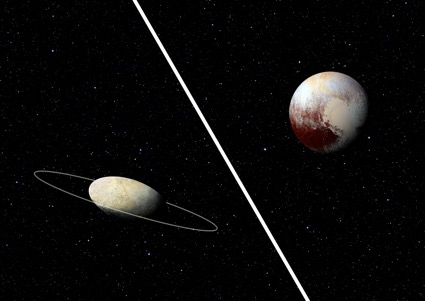The trans-neptunian region is a huge zone in the external region of the Solar System which ranges from the Kuiper belt up to the Oort cloud. Pluto, discovered in 1930, and Éris, discovered in 2005 are part of it and are the two largest (in terms of size) dwarf planetts known till now. Situated in the Kuiper belt, at an average distance of 43 astronomical units from the Sun, Hauméa belongs to this same category of body. It has two satellites : Hiʻiaka and Namaka. Unlike the other dwarf planets, its size, its shape, is reflectivity (albedo) and its density are poorly known.

À droite : une image en fausse couleur de Pluton (montrée à la même échelle que Hauméa) prise lors du survol de la sonde NASA New Horizons en juillet 2015.
On January 21st 2017,the occultation by Hauméa of the star URAT1 533-182543 led to a huge observational campaign coordinated on a European scale by José Luis Ortiz from Andaluisian Institute of Astrophysics (Spain). These observations, whose results are published in a letter to Nature dated October 11th 2017, have enabled the surprising characteristics of Hauméa, already known for its cigar-like ellipsoidal shape and for its rapid rotation, to be refined.
Hauméa is an ellipsoid, swhose three axes are, respecttively 2 320 km,
1 705 km and 1 025 km long. The value of 2 320 km is in reality a lower limit ; in view of these values, it turns out to be almost larger than Éris (with a diameter of 2 325 km), and even Pluto (with a dimeter of 2 375 km).
There is still another surprise. Observation has revealed the existence of a dense ring around the dwarf planet, a major first as far as transneptunian bodies are concerned.

With a radius of 2 290 km, the ring orbits the planet in the equatorial plane ; this would also appear to be the orbital plane of Hi’iaka, its main satellite. It is about 70 km. wide Its opacity is about 50 %, and so it absorbed about one half of the luminous flux of the star during the occultation.
This discovery follows that made in 2013 of a dense ring around the assteroid Chariklo, which is a much smaller body with a diameter of about 260 km situated in the region between Saturn and Uranus. Rings thus seem to be a general feature of the giant planets : Jupiter, Saturn, Uranus and Neptune. This recent discovery raises the possibility that their existence around the icy bodies in the distant transneptunian regions could well be less rare than was believed till now.
However, the origin and the stability of the rings around Chariklo and Haumea raises numerous questions. The presence of satellitess around Haumea, as well as of a family of bodies associated with this dwarf planet, does suggest that this recently discovered ring could have a collisional origin.
« Furthermore, the very elongated shape of Hauméa could well induce important resonant perturbations in a surrounding collisional disc. This could explain the current position of the rings, which are relatively far from the central body », comments Bruno Sicardy, co-discoverer of the ring.
Further theoretic work will soon be published to confirm these hyptheses.
Reference
This research is published in a paper entitled « The size, shape, density and ring of the dwarf planet Haumea from a stellar occultation », as a letter to Nature, dated October 11th 2017.
doi : 10.1038/nature24051
Collaboration
These results have been obtained thanks, in part, to financial support furnished by the European Research Council’s project ’Lucky Star’, dirigé par Bruno Sicardy (ERC Advanced Grant n°669416). The fruit of a collaboration between European Institutes, it has involved the participation of scientists working at the Paris Observatory, from the Laboratoire d’études spatiales et d’instrumentation en astrophysique (Observatoire de Paris / CNRS / UPMC / Université Paris Diderot) and from the Institut de mécanique céleste et de calcul des éphémérides (Observatoire de Paris/CNRS/UPMC/Université de Lille), as well as scientists from the Grenada (Spain) Andalusian Institute of Astrophysicsand from the Observatoire National et de Valongo de Rio de Janeiro - the National Observatory of Valongo at Rio de Janeiro (Brazil).

![<multi>[fr]pdf[en]pdf</multi>](IMG/gif/pdf.gif)
